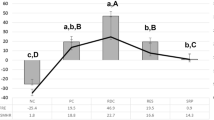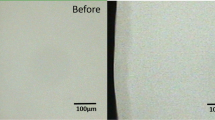Abstract
Objective
This study aimed to determine whether the application of a high-fluoride gel could increase the remineralization of subsurface dentin lesions stored in saliva substitutes.
Materials and methods
Demineralized bovine dentin specimens were stored in mineral water (W), Glandosane (G), or modified Saliva natura (SN). Different treatments were applied twice daily: no treatment, Elmex sensitive mouth rinse (E), ProSchmelz gel (P), Duraphat toothpaste (D), ED, PD, and EPD. Differences in mineral loss were evaluated by transversal microradiography after 2 and 5 weeks.
Results
The treatments with E, D, and ED inhibited the mineral loss induced by G and enabled some mineral gain. ProSchmelz was not able to inhibit the demineralizing effect of G. This high-fluoride gel induced an erosive mineral loss in combination with G. The use of ProSchmelz in combination or not with other fluoride products did not increase remineralization of specimens stored in SN or W (p > 0.05). ProSchmelz resulted in an erosion of the specimens stored in W and revealed a lower mineralized surface layer of specimens stored in SN.
Conclusion
Topical application of high-fluoride gel reduced the mineral loss induced by G but resulted in an erosion of specimens’ surface. In addition, ProSchmelz did not demonstrate beneficial effects in combination with SN on subsurface dentin lesion remineralization.
Clinical relevance
Within the limitations of an in vitro study, it was concluded that the application of a high-fluoride gel did not promote additional effects on remineralization of subsurface dentin lesions in combination with saliva substitutes when compared to products with lower fluoride concentration.


Similar content being viewed by others
References
Tschoppe P, Wolgin M, Pischon N, Kielbassa AM (2010) Etiologic factors of hyposalivation and consequences for oral health. Quintessence Int 41:321–333. doi:10.1159/000302901
Vissink A, Jansma J, Spijkervet FK, Burlage FR, Coppes RP (2003) Oral sequelae of head and neck radiotherapy. Crit Rev Oral Biol Med 14:199–212
Kielbassa AM, Hinkelbein W, Hellwig E, Meyer-Lückel H (2006) Radiation-related damage to dentition. Lancet Oncol 7:326–335
Hahnel S, Behr M, Handel G, Bürgers R (2009) Saliva substitutes for the treatment of radiation-induced xerostomia—a review. Support Care Cancer 17:1331–1343. doi:10.1007/s00520-009-0671-x
Nieuw Amerongen AV, Veerman EC (2003) Current therapies for xerostomia and salivary gland hypofunction associated with cancer therapies. Support Care Cancer 11:226–231
Momm F, Volegova-Neher NJ, Schulte-Mönting J, Guttenberger R (2005) Different saliva substitutes for treatment of xerostomia following radiotherapy. A prospective crossover study. Strahlenther Onkol 181:231–236
Kielbassa AM, Shohadai SP, Schulte-Mönting J (2001) Effect of saliva substitutes on mineral content of demineralized and sound dental enamel. Support Care Cancer 9:40–47
Meyer-Lueckel H, Schulte-Mönting J, Kielbassa AM (2002) The effect of commercially available saliva substitutes on predemineralized bovine dentin in vitro. Oral Dis 8:192–198
Smith G, Smith AJ, Shaw L, Shaw MJ (2001) Artificial saliva substitutes and mineral dissolution. J Oral Rehabil 28:728–731
Meyer-Lueckel H, Kielbassa AM (2006) Influence of calcium phosphates added to mucin-based saliva substitutes on bovine dentin. Quintessence Int 37:537–544
Tschoppe P, Kielbassa AM, Toll R, Meyer-Lueckel H (2009) Modification of the mineralizing capacity of a saliva substitute (saliva natura) on enamel in vitro. Laryngorhinootologie 88:717–722. doi:10.1055/s-0029-1224107
Spak CJ, Johnson G, Ekstrand J (1994) Caries incidence, salivary flow rate and efficacy of fluoride gel treatment in irradiated patients. Caries Res 28:388–393
Meyerowitz C, Featherstone JD, Billings RJ, Eisenberg AD, Fu J, Shariati M et al (1991) Use of an intra-oral model to evaluate 0.05 % sodium fluoride mouthrinse in radiation-induced hyposalivation. J Dent Res 70:894–898
Papas A, Russell D, Singh M, Kent R, Triol C, Winston A (2008) Caries clinical trial of a remineralising toothpaste in radiation patients. Gerodontology 25:76–88. doi:10.1111/j.1741-2358.2007.00199.x
Zandim DL, Tschoppe P, Sampaio JE, Kielbassa AM (2011) Effect of saliva substitutes in combination with fluorides on remineralization of subsurface dentin lesions. Support Care Cancer 19:1143–1149. doi:10.1007/s00520-010-0924-8
Tschoppe P, Zandim DL, Sampaio JE, Kielbassa AM (2010) Saliva substitute in combination with high-concentrated fluoride toothpaste: effects on demineralised dentin in vitro. J Dent 38:207–213. doi:10.1016/j.jdent.2009.10.005
Shellis RP (1988) A microcomputer program to evaluate the saturation of complex solutions with respect to biominerals. Comput Appl Biosci 4:373–379
Meyer-Lueckel H, Cölfen H, Verch A, Tschoppe P (2010) Effects of carbmethyl cellulose-based saliva substitutes with varying degrees of saturation with respect to calcium phosphates on artificial enamel lesions. Caries Res 44:127–134
Ruben J, Arends J (1993) Shrinkage prevention of in vitro demineralized human dentine in transversal microradiography. Caries Res 27:262–265
Backfolk K, Lagerge S, Rosenholm JB, Eklund D (2002) Aspects on the interaction between sodium carboxymethylcellulose and calcium carbonate and the relationship to specific site adsorption. J Colloid Interface Sci 248:5–12
McCracken MS, Haywood VB (1995) Effects of 10 % carbamide peroxide on the subsurface hardness of enamel. Quintessence Int 26:21–24
Basting RT, Rodrigues ALJ, Serra MC (2003) The effects of seven carbamide peroxide bleaching agents on enamel microhardness over time. J Am Dent Assoc 134:1335–1342
Basting RT, Rodrigues AL Jr, Serra MC (2005) The effect of 10 % carbamide peroxide, carbopol and/or glycerin on enamel and dentin microhardness. Oper Dent 30:608–616
Vissink A, Burlage FR, Spijkervet FK, Veerman EC, Nieuw Amerongen AV (2004) Prevention and treatment of salivary gland hypofunction related to head and neck radiation therapy and chemotherapy. Support Cancer Ther 1:111–118. doi:10.3816/SCT.2004.n.004
Schemehorn BR, Orban JC, Wood GD, Fischer GM, Winston AE (1999) Remineralization by fluoride enhanced with calcium and phosphate ingredients. J Clin Dent 10:13–16
Tschoppe P, Meyer-Lueckel H (2011) Mineral distribution of artificial dentinal caries lesions after treatment with fluoride agents in combination with saliva substitutes. Arch Oral Biol 56:775–784. doi:10.1016/j.archoralbio.2011.01.002
Kawasaki K, Ruben J, Tsuda H, Huysmans MC, Takagi O (2000) Relationship between mineral distributions in dentine lesions and subsequent remineralization in vitro. Caries Res 34:395–403
Christoffersen J, Christoffersen MR, Kibalczyc W, Perdok WG (1988) Kinetics of dissolution and growth of calcium fluoride and effects of phosphate. Acta Odontol Scand 46:325–336
Chander S, Chiao CC, Fuerstenau DW (1982) Transformation of calcium fluoride for caries prevention. J Dent Res 61:403–407
Tschoppe P, Meyer-Lueckel H, Toll R, Kielbassa AM (2007) In vitro analysis of an new saliva substitute (Saliva natura) on enamel and dentin. Laryngorhinootologie 86:723–727
Larsen MJ, Pearce EI (2003) Saturation of human saliva with respect to calcium salts. Arch Oral Biol 48:317–322
Gelhard TB, Fidler V, s-Gravenmade EJ, Vissink A (1983) Remineralization of softened human enamel in mucin- or CMC-containing artificial salivas. J Oral Pathol 12:336–341
Vissink A, Gravenmade EJ, Gelhard TB, Panders AK, Franken MH (1985) Rehardening properties of mucin- or CMC-containing saliva substitutes on softened human enamel. Effects of sorbitol, xylitol and increasing viscosity. Caries Res 19:212–218
Damato FA, Strang R, Stephen KW (1990) Effect of fluoride concentration on remineralization of carious enamel: an in vitro pH-cycling study. Caries Res 24:174–180
Baysan A, Lynch E, Ellwood R, Davies R, Petersson L, Borsboom P (2001) Reversal of primary root caries using dentifrices containing 5,000 and 1,100 ppm fluoride. Caries Res 35:41–46
Ruissen AL, Groenink J, Lommerse CH, Van’t Hof W, Veerman EC, Nieuw Amerongen AV (2002) Effects of carbohydrate polymers applicable in saliva substitutes on the anti-Candida activity of a histatin-derived peptide. Arch Oral Biol 47:749–756
Epstein JB, van der Meij EH, Lunn R, Stevenson-Moore P (1996) Effects of compliance with fluoride gel application on caries and caries risk in patients after radiation therapy for head and neck cancer. Oral Surg Oral Med Oral Pathol Oral Radiol Endod 82:268–275
Acknowledgments
The authors would like to thank Coordenação de Aperfeiçoamento de Pessoal de Nível Superior (CAPES) (Brasília, DF, Brazil) and Forschungsgemeinschaft Dental e.V. (Cologne, Germany) for providing financial support and Mr. Rainer Toll (Charité - Universitätsmedizin Berlin) for his technical support during the laboratory work. Experiments have been conducted at the Department of Operative Dentistry and Periodontology (Charité - Universitätsmedizin Berlin), which is greatly acknowledged.
Conflict of interest
The authors declare that they have no conflict of interest.
Author information
Authors and Affiliations
Corresponding author
Additional information
Daniela Leal Zandim-Barcelos and Peter Tschoppe contributed equally to this paper.
Rights and permissions
About this article
Cite this article
Zandim-Barcelos, D.L., Kielbassa, A.M., Sampaio, J.E.C. et al. Saliva substitutes in combination with high-fluoride gel on dentin remineralization. Clin Oral Invest 19, 289–297 (2015). https://doi.org/10.1007/s00784-014-1264-8
Received:
Accepted:
Published:
Issue Date:
DOI: https://doi.org/10.1007/s00784-014-1264-8




